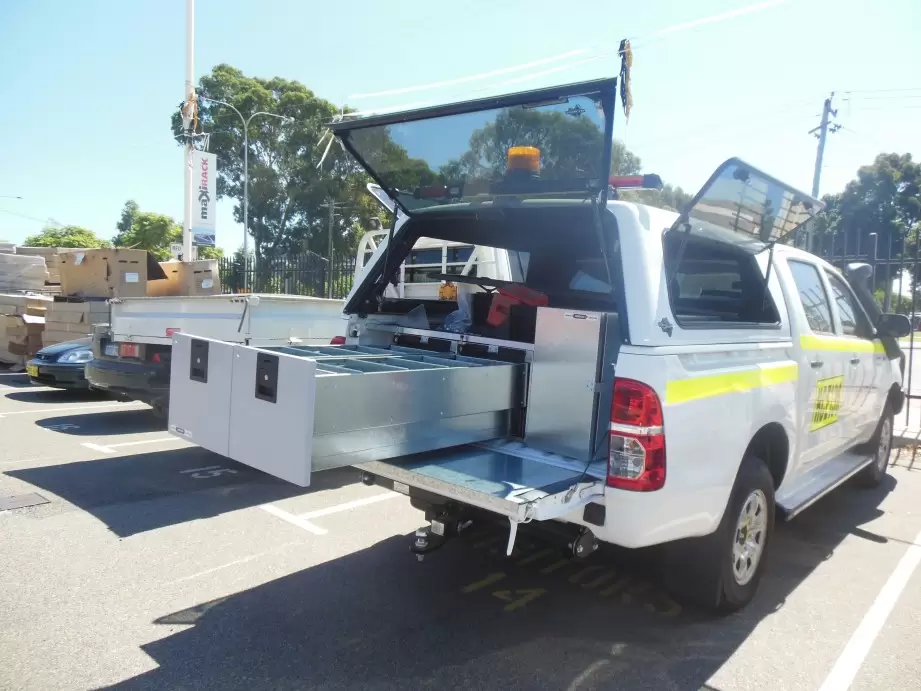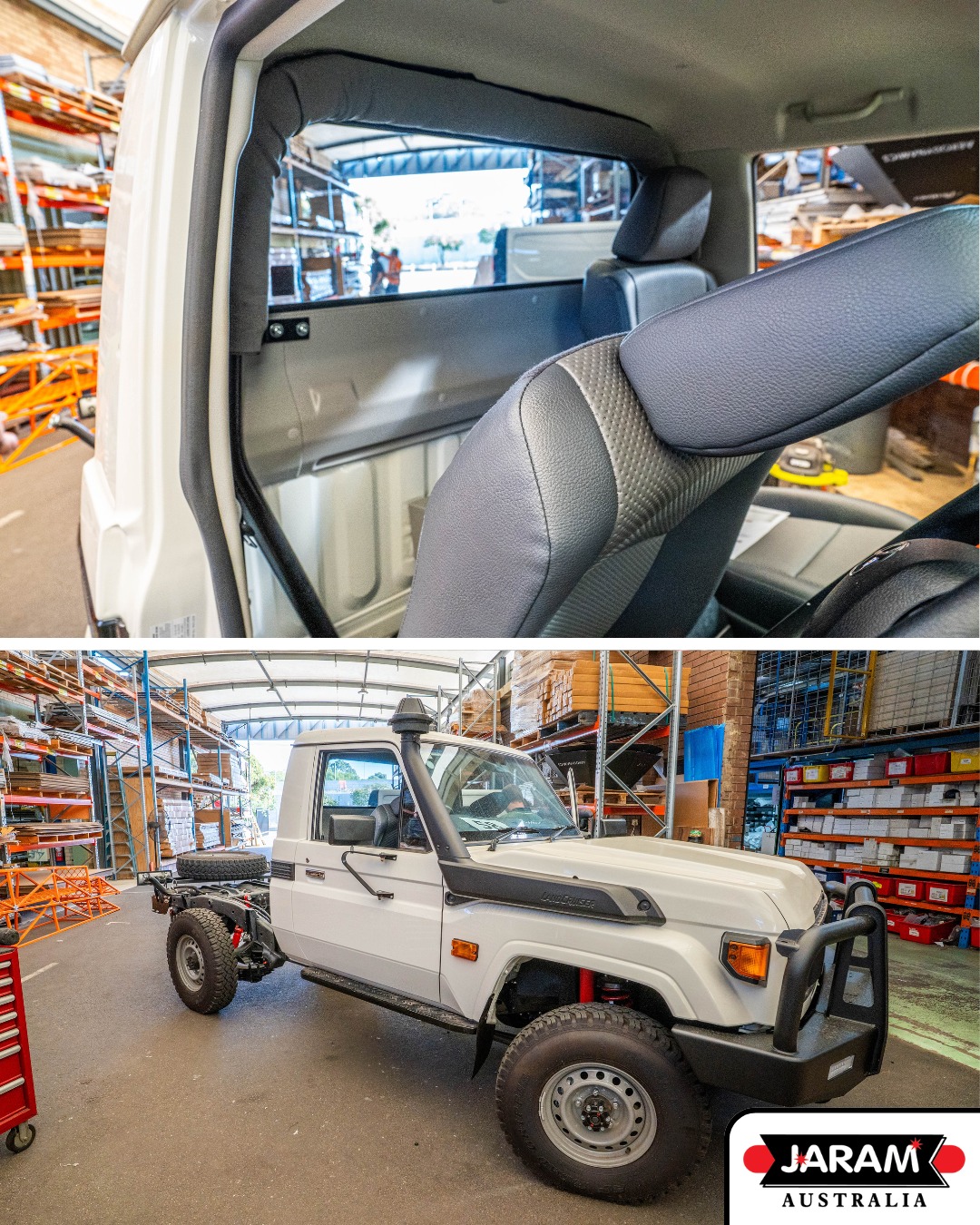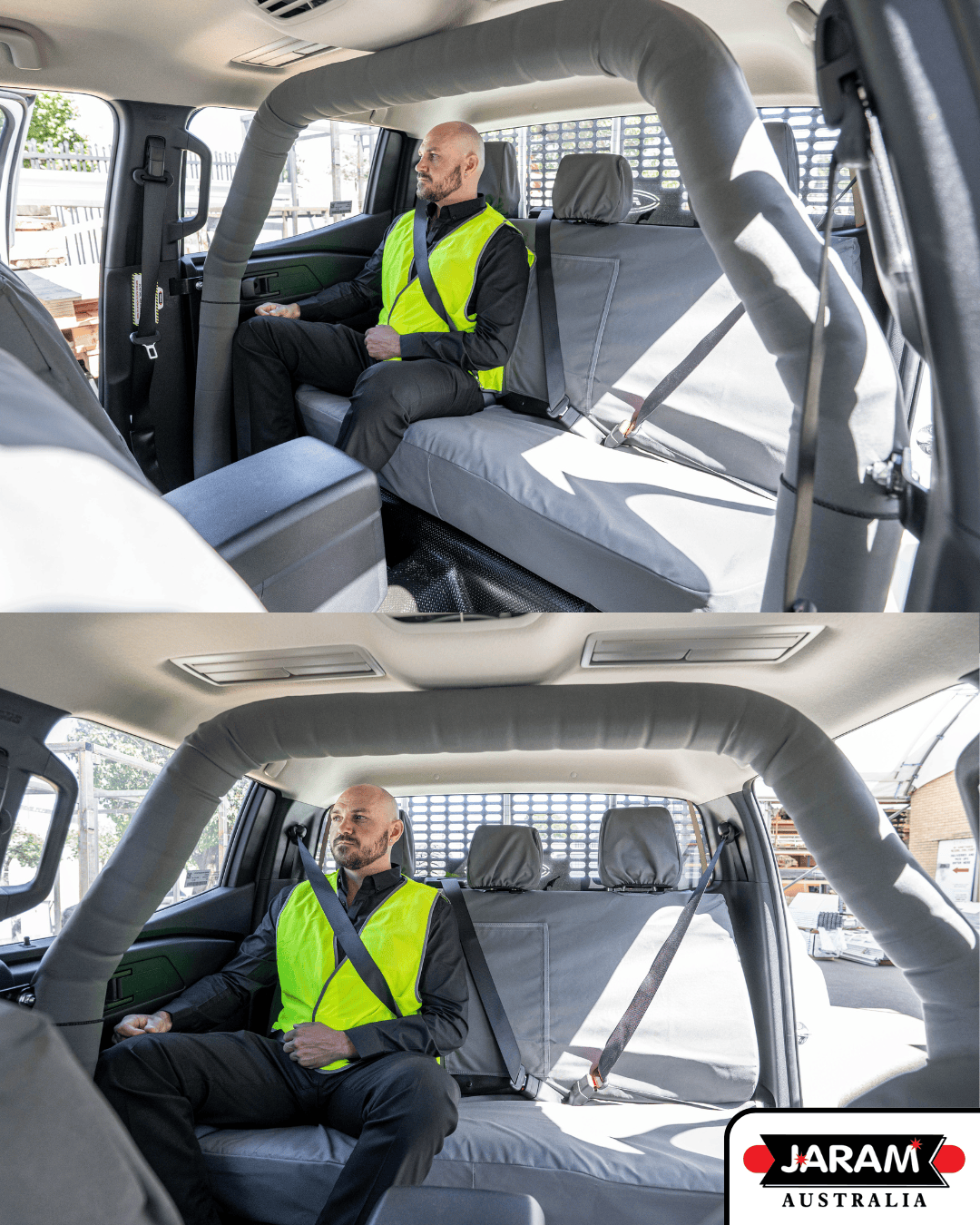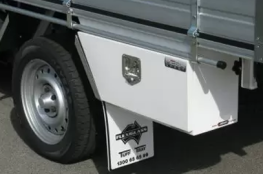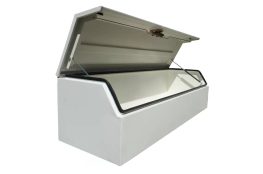Mine spec vehicle requirements usually includes rollover protective structures (ROPS), communications enhancements, and warning lights. These strict requirements are set by mining corporations and states to ensure safety and efficiency at mine sites.
With years of selling products for mine spec upgrades and completing custom fit-outs, we know how important these regulations are in the mining industry.
In this guide, we’ll cover general mine spec vehicle requirements and site-specific requirements to ensure your vehicle’s compliance.
What Is Required for a Mine Spec Vehicle?
Mine spec upgrades vary based on site and state. Still, you can expect the same standard safety upgrades at just about any mine site in WA.
| Mine Spec Vehicle Requirement | Why It Is Required | Purpose |
| Roll over protection structures (ROPS) | Challenging, rugged terrain and difficult conditions that increase the chance of rollover accidents | Reinforce the vehicle’s frame to prevent the cab from collapsing during a rollover; ensure the protection of occupants by forming a ‘safety bubble’ |
| Heavy-duty tyres and spill kits | Rough terrain increases the chance of spills and fluid leaks and necessitates durable tyres | Navigate rough terrain more easily and have a spill kit to promptly and effectively address fluid leaks |
| Seat belts and safety harnesses | Increased risk of accidents at mine sites due to low visibility, difficult terrain, and obstacles | Help protect drivers and passengers by keeping them secure when navigating rough terrain or in the event of an accident |
| Brake system upgrades | Control and fast reaction time are crucial for safely navigating challenging, technical terrain and sudden stops | ABS brakes help prevent skidding, improve traction, and reduce the chance of wheel lock during sudden stops |
| Fire extinguishers and first aid kits | Increased risk of fires, explosions, and accidents | Ensure fires and accidents can be handled appropriately and quickly |
| Battery isolators | High risk of fires; danger of electrical hazards | Deactivate a vehicle in the event of a fire; prevent accidental startups |
| Lighting and signals | Frequent low visibility conditions | Increase visibility to prevent collisions and accidents |
| In-vehicle monitoring system | Factors such as speed play a role in accidents on rough, uneven terrain and unpredictable conditions | Record driver data, such as speed, to monitor behaviors for safety reasons; record distance travelled and other important data to be used for planning purposes |
| Emergency stop devices | Obstacles and low visibility make it necessary to have easily accessible emergency stop devices | Reduce the risk of accidents, injuries, or collisions |
| Exhaust treatments | Risk of excessive exhaust or harmful fumes from heavy machinery and equipment | Monitor exhaust and adjust if necessary to maintain safe air quality at mine sites |
| UHF or VHF radios | Expansive, remote locations with poor to no signals | Provide reliable communication even in the most remote regions or over long distances |
Rollover Protection Structures (ROPS)
Rollover protection is one of the upgrades required for mine spec vehicles. Some mine sites will outright deny the minespec vehicle to enter the site without a certified ROPS. ROPS certified in mining need to adhere to VSB14 , LK9 and LK10 compliance.With a high risk of rollovers at mine sites, ROPS / Roll bars strengthens the vehicle’s frame to protect occupants in case of a rollover incident.
Heavy-Duty Tyres and Spill Kits
Heavy-duty tyres are better equipped to handle the rugged terrain at mine sites, reducing the risk of damage or downtime from a blown tyre. Spill kits ensure that fluid leaks and spills can be cleaned up fast and effectively.
Seat Belts and Safety Harnesses
Vehicles must feature seat belts that comply with Australian Design Rules or AS 2664.
Appropriate Braking Systems
WA mine spec vehicles must have the ability to stop quickly in technical terrain without skidding. 5 Star Ancap Rating also helps.Service brakes, emergency brakes, and parking brakes are required. For towing vehicles, an electric brake controller is also required. Brakes must also be tested and maintained in accordance with the manufacturer’s specifications.
Fire Extinguishers and First Aid Kits
Mine sites often face a high risk of fires or explosions, making it crucial to have fire extinguishers and first aid kits ready. Diesel units rated 125 kW or more are required to have an AFFF or FFFP fire suppression system. Remote-controlled units need to have an automatic fire suppression system with remote-activation capabilities.
Battery Isolators
Battery isolators make it easy to electronically deactivate a vehicle if needed. This is crucial as there is a high risk of electrical hazards and fires on mine sites.
Lighting and Signals
The low light, obstacles, and dusty conditions often limit visibility at mine sites. Lighting and signal upgrades help increase visibility despite these conditions, reducing the risk of accidents or collisions. Mine spec vehicles need:
- Proper turn indicators
- Audible warning signals
- Effective tail lights and headlights
- A flashing cab light
- Flashing beacons
- High visibility flags
IVMS (In-Vehicle Monitoring System)
In-vehicle monitoring systems track data, such as speed or distance travelled. It can also be used to monitor driver behaviours to ensure safe driving speeds are adhered to.
Emergency Stop Devices
Easy-to-access, clearly marked emergency stop devices are required in mine spec vehicles.
Exhaust Treatments
Turbocharged or diesel units rated at 125 kW must have compliant and properly maintained exhaust treatment devices. Defective devices must be replaced immediately. Regular emission samples must be analysed.
UHF or VHF Radios
Mine sites are typically remote, often with weak signals or none at all. VHF or UHF radios ensure secure, dependable communication despite weak signals in remote areas.
Mine Spec Requirements by State
Mine Spec Vehicle Requirements in WA
Mine spec vehicle requirements in WA include:
- Proper braking systems, including service, emergency, and parking brakes
- Regular brake testing and maintenance according to the manufacturer’s specifications
- Earthmoving machinery must have roll-over protective structures (ROPS) in compliance with AS 2294
- Easily accessible and clearly labeled emergency stop devices
- Proper fire suppression systems
- Seat belts that conform to Australian Design Rules or AS 2664
- A flashing light in the cab for light service vehicles or personnel transport vehicles
- Adequate lighting and audible warning signals, turn indicators, tail lights, and headlights
- Adequate exhaust treatments and emissions testing
- Proper ventilation
This is just a basic overview of WA’s mine spec requirements. See all the regulations and details here: The Mines Safety and Inspection Regulations 1995.
Mine Spec Vehicle Requirements in Queensland
The Mining and Quarrying Safety and Health Regulation 2017 outlines Queensland Mine Spec Vehicle requirements, which include:
- Service, emergency, and parking brake systems that are tested and maintained according to the manufacturer’s specifications
- Roll over protection for earth-moving machinery that conforms to AS 2294
- Exhaust treatments, gas sampling, and emissions testing
- Seat belts in accordance with AS 2664 or Australian Design Rules
- Ventilation requirements
- Appropriate fire suppression systems
- Effective headlights, tail lights, audible warning signals, and turn indicators. A flashing cab light for light service vehicles and personnel transport vehicles.
Specific Requirements by Major Mining Companies
FMG Mine Spec Vehicle Requirements
FMG mine spec vehicle requirements prioritise warning devices, fixed seats, pre-operation safety checks, and other safety features, including:
- Electronic Stability Control (ESC)
- Three-point seat belts with pretensioners
- Anti-Lock Braking Systems (ABS)
- Safety belts and fixed seats for all passengers and the driver (unless otherwise approved)
- Restricted use of a vehicle to tow any equipment unless it is engineered specifically for towing
- Side, front, and curtain, and airbags
- Appropriate braking systems that are periodically tested for effectiveness
- Speedometers and warning devices to reduce accidental collisions with objects or pedestrians
- Pre-operational safety checks according to a schedule based on a risk assessment
Rio Tinto Mine Spec Vehicle Requirements
Rio Tinto mine spec vehicles must have:
- Anti-lock Braking System (ABS)
- Electronic Stability Control (ESC)
- Fixed seats and safety belts for all passengers and the driver
- Front, side, and curtain airbags
- Three-point seat belts with pretensioners
- Speedometre with warning devices to reduce the risk of collisions with people or objects
- No towing with vehicles unless they are manufactured for towing purposes
- Regularly testing for brake system effectiveness
BHP Mine Spec Vehicle Requirements
BHP Mine Spec Vehicle Requirements include:
- Electronic Stability Control (ESC)
- A journey risk assessment and management plan
- Anti-lock Braking System (ABS)
- Compliant fire suppression systems and fire extinguishers
- 3-point seat belts for each occupant
- Properly sized and maintained tyres
- Monitoring systems that track data and driver behavior
- Any HOV drivers must have all relevant licensing
- 5-star safety ratings from a recongised vehicle assessment program (ie, NHTSA or ANCAP)
- “Good” rating for both frontal and side crash tests from IIHS
- Aftermarket modifications are prohibited if they reduce the vehicle’s safety features
There are also additional mine spec vehicle requirements for High Occupancy Vehicles. Also referred to as HOVs, these vehicles are capable of carrying nine or more people and require:
- 3-point seat belts for every occupant
- Fire extinguishers or fire suppression systems
- Systems for collecting data and monitoring driver behaviour, such as speed
- ABS (Anti-lock Braking System)
- ESC (Electronic Stability Control)
- Appropriate tyre selection and regular maintenance
- A journey risk assessment and management plan for all HOV journeys
*Vehicles that do not meet the Appendix 1 requirements must undergo a detailed risk assessment.
BMA Mine Spec Vehicle Requirements
The BMA mine spec vehicle requirements adhere to many of the same BHP safety standards. As with BHP mine spec requirements, BMA also requires additional safety features for HOVs, such as data monitoring systems, fire suppression systems, and relevant licenses for all HOV drivers.
Along with the standard mine spec vehicle upgrades, BMA may also require custom safety features. For instance, additional dust protection may be required if a site is at risk of low visibility and dense dust.
For more information, you can review BHP’s safety requirements here.
Why It’s Important to Have a Compliant Mine Spec Vehicle
Mine spec vehicle upgrades may sound strict, but these regulations have saved lives in Australia.
Having a compliant mine spec vehicle is crucial for:
- The safety of mine workers
- Safely navigating the often hazardous conditions and rugged terrain of mine sites
- Ensuring reliable, effective communication in remote mine site locations where signals may be limited or unavailable
- Ensuring visibility in dusty conditions
- Equipping the vehicle to handle unpredictable weather
- Enhancing the safety of the driver and passengers in the event of a rollover
- Protecting against fire dangers, poor air quality, and toxic emissions
- Preventing downtimes due to vehicle failure as a result of rough terrain and challenging conditions
- Protecting vehicle occupants from serious injury or death in the event of a rollover
What Sets Our Internal ROPs Apart?
Custom vehicle fit-outs ensure maximum compliance with WA mine spec vehicle requirements, safety, and effectiveness. One of the biggest areas we focus on during fitouts is rollover protection.
We offer a range of internal ROPS systems at Jaram that are:
- Manufactured in-house and fully compliant with Australian Standards VSB14, LK9 & LK10
- Approved by the Department of Transport and trusted by Tier 1 miners across Australia
- Backed by our comprehensive 5-year warranty
Browse our full range of ROPs here by GVM:
- Light Vehicle Internal ROPS / Roll Bar (Below 4500 GVM)
- Heavy Vehicle Truck (4500-8000kg GVM)
- Ultra Heavy Duty Truck ROPS (8000-15000kg GVM)
- Extra Heavy Duty Truck ROPS (15000-30000kg GVM)
Read more about what sets our internal ROPs apart here: Australian-Made & Tier 1 Miner-Approved: Jaram’s Internal ROPS.
How Jaram Australia Can Help
Mine spec vehicle requirements ensure vehicles are equipped to safely face the frequent dangers posed by mine sites.
Despite challenges posed by poor visibility, risk of injuries and fire, and rugged terrain, the right upgrades can ensure mine spec vehicles can operate safely and efficiently.
Jaram has successfully outfitted mine spec vehicles across WA, ensuring effectiveness and regulatory compliance. Contact us to schedule your custom mine spec vehicle fit-out or discuss your mine site requirements.
Frequently Asked Questions
What Is Mine Spec?
Mine specs refer to the specific requirements for vehicles operating at mining sites, such as roll over protection structures. General mine spec requirements include a variety of crucial safety upgrades to protect drivers, passengers, and workers at mine sites.
What is Required for a Mine Spec Vehicle?
Mine spec vehicle requirements vary by mining corporation and state, but the general upgrades include:
- Rollover protection structures (ROPS)
- Communication upgrades
- Visibility upgrades
- Seat belts and fixed seats
- Warning signals
- Exhaust system upgrades and monitoring systems
- Fire suppression equipment
- First aid kits
- Emergency stop devices
- Proper braking systems and brake system monitoring
- Data monitoring systems
How Do Mine Spec Vehicle Regulations Help Prevent Accidents on Rugged Terrains?
Mine spec requirements reduce the risks of accidents at mine sites in several ways. One of the biggest ways mine spec vehicles enhance safety is with roll-over protective structures. Mine sites often feature rugged, hazardous terrain that increases the chance of accidents and rollovers. In the event of a rollover, ROPS act as a “bubble”, ensuring occupants are protected in the cabin area.
Along with rollover protection, mine spec vehicles also help reduce the risk of dangers posed by fires or poor air quality. Communication enhancements and visibility upgrades help increase safety amidst poor signals or dusty or hazy conditions.
Information Disclaimer
The content of this article is meant for informational purposes only and should not be considered a source of professional advice, recommendations, or endorsements. It is not a substitute for seeking expert guidance or making well-informed decisions based on individual circumstances. Although we strive for accuracy and reliability, we cannot guarantee the information's completeness or suitability for all situations. Readers are urged to verify facts, consult experts, and consider their own context before taking actions or decisions based on this content. No warranties, explicit or implied, are provided regarding the accuracy, timeliness, or completeness of the presented information. Relying on this information is at the reader's own discretion and risk. We encourage readers to consult relevant professionals or experts for advice tailored to their specific needs. Neither the author, publisher, nor any affiliated parties will be held responsible for errors, omissions, or damages resulting from the use or reliance on the information in this article.

